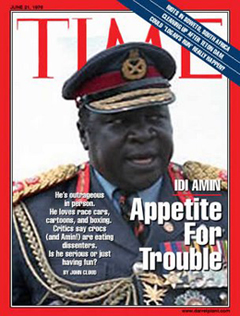
The Islamic Legion
Gaddafi’s former Mercenaries
There has been much talk recently of Gaddafi’s mercenaries. False reports have mingled with rumours and half truths, and yet it is certain that such fighters are used, and that most of them come from sub-Saharan Africa. Occasionally there are also references to the Islamic Legion, a Libyan mercenary unit, which was in action between 1972 and 1987 but little noticed by the world. Given recent events it may be worthwhile to examine its short history more closely.
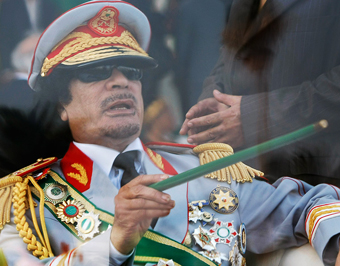
The many hardships Muammar Gaddafi has caused his fellow human beings can probably be traced to his boundless ambition and impatience and the volatility with which he has pursued his goals. His stated aim was to unite all Arab states, to win new countries for Islam and impose his stamp on the entire world. Under his direction attempts were made at various times to unite Libya with Egypt, Sudan, Tunisia, Morocco, Syria, Chad, and a number of other countries. More often than not these large federations collapsed with the severing of diplomatic relations or even declarations of open war, if the chosen partner noticed that Gaddafi, in his desire for more rapid progress, simultaneously supported attempted coups in their countries. The Arab leaders quickly realised that the colonel’s fraternal embraces could have deadly consequences.
Like many young officers of his generation, Gaddafi, who came to power in 1969 with a coup d’état, was deeply impressed by the revolutionary impetus of socialism and tried to instigate his own version of “Islamic socialism”. He summarized these ideas in his Green Book, which was intended to be a kind of Mao’s Little Red Book for the Arabic world. Since sparsely populated Libya was no match for her powerful neighbors Algeria and Egypt – or Tunisia, over which France held her protective hand – the book proposed disseminating its ideas with the help of revolutionary forces and subversive groups. Because there was no lack of money, Libya became the principal supporter of numerous terrorist groups from Palestine to Indonesia. But help wasn’t reserved only for Islamic terrorists, even Catholic groups such as the Spanish ETA or the IRA received material assistance or found refuge in Libya.
But all these groups proved difficult to control and only rarely accepted direct orders. It became clear that Gaddafi would need his own organisation to carry out his great plans, so he founded the “al-Failaka al-Islamiya,” or Islamic Legion in 1972. It is possible that he was inspired in part by the French Foreign Legion, which had fought so valiantly all over the world, allowing France to spare shedding the blood of her own citizens. It is probable that he also had something in mind like the International Brigades during the Spanish Civil War. Brave idealists from all Arab countries would now have the opportunity to die for Gaddafi’s goals.
The idea that Arab idealists would be prepared to die for another country’s leader was not entirely unfounded. Thanks to its enormous oil reserves Libya was by far the richest country in North Africa. The problem was that there wasn’t enough personnel to man all of the wonderful equipment purchased with the oil billions. Thus, in the mid-70s the Libyan Army had only 300 crew for the 2,500 tanks rusting in their depots. Libya was generally short on people and, as in many oil states, the economy was kept going by tens of thousands of foreign workers. Military service was especially unpopular, and so it was obvious to fall back on foreigners for this also.
There was, unfortunately, one big catch: there were few real volunteers. Bin Laden and Al Qaeda were still in the distant future, and very few Arabs were willing to risk their lives for Gaddafi’s grandiose plans. But there was yet another resource. Due to several severe droughts, many semi-nomads from the Sahel, Mali, Niger, Chad and Sudan had come to Libya and were leading a miserable existence in refugee camps. Furthermore there were political exiles from these and other countries who had fought in vain for more autonomy in their homelands. West Africans were also continually flooding in, risking the long journey across the Sahara to find work in Libya.
The majority of the Islamic Legion was recruited from among these poor souls. Some of them were seduced with the promise that they would one day return as victorious liberators to their home countries, but most came, as so often in the history of mercenaries, for regular pay and food. Normally the recruiters concealed from the future legionnaires their true destination. Many who had sought only a job found themselves suddenly in a training camp somewhere in the desert. If there still weren’t enough recruits, the police seized immigrants along the roadside and confronted them with a harsh choice: deportation or service in the Islamic Legion.
Since Libya fought no wars in the first years of the Legion, the build-up went slowly. Although some groups were sent to Chad and to Lebanon to support the Palestinians, the majority spent their time training. However, it seems that the training was limited mainly to ideological indoctrination and reading the Green Book, something which is underlined by the subsequent combat operations. The abstruse mix of Islam and socialism was spiced with a generous quantity of pure racism, which stylized the Arabs as a chosen people vastly superior to all others. This racist ideology, although ostensibly directed against Israel and the decadent West, served mainly to promote Arab – which meant, of course, Libyan – delusions of grandeur on the southern edge of the Sahara.
Among the legionnaires, who could count for Arabs, these ideas certainly fell on fertile ground. Nevertheless, service in the desolate desert camps was hard and exceptionaly tedious. This became evident when tensions with former sister state Egypt escalated into a border war in June 1977. The Egyptians taught the Libyans a bitter lesson, bombing several bases and conducting commando raids on Legion training camps near the border, which were suspected (not without reason) to be harbouring terrorists in training for missions in Egypt. Afterwards many of prisoners taken asked for political asylum in Egypt, and some even worked in Cairo broadcasting anti-Libyan propaganda on the radio.

The Legion’s first major mission was a year and a half later, in Uganda. Because Idi Amin was a Muslim, Gaddafi had supported him for years with military advisers and matériel. He hoped in this way to win over the country with its Christian majority for Islam. After all, “Emperor” Bokassa had enjoyed the same brotherly help after he converted to Islam. In the fall of 1978 Idi Amin invaded the north of Tanzania, since many Ugandans had taken refuge there. After some initial successes however, the Tanzanians mobilised their troops, armed the Ugandan exiles and defeated Idi Amin’s poorly motivated troops. Not content with that, they pursued the Ugandans and marched victorious towards Kampala.
Gaddafi was obviously not willing to sit by idly. He had more than enough war matériel, and soon enormous transport aircraft were flying to Entebbe with T55-tanks, Katyusha rocket launchers and artillery pieces. Providing the necessary troops wasn’t that easy, as nobody in Libya wanted to die for Idi Amin somewhere in the African bush. The first contingent of 2,500 men consited therefore only of a small proportion of regular troops, the rest being militiamen and legionnaires, who hadn’t been told the destination in order not to spoil the fighting spirit. In March 1979 they came upon the advancing Tanzanians at Lukuya southwest of Entebbe. The encounter came as a surprise to both sides and the Libyans were able to deploy the superior firepower of their tanks and rocket launchers with great success. The Tanzanians, who possessed no heavy weapons, were defeated and fled.
But after this easy victory a mixture of arrogance, incompetence and lack of motivation became apparent, which would be typical of the later wars. The Libyans not only refrained from pursuing the defeated enemy, but also failed to fortify their own position or send out patrols. Therefore they were completely caught off guard by the Tanzanian counter-attack the following day. In the general chaos, they were unable to make much use of their firepower. At first the poorly-trained militiamen and the legionnaires took flight, but soon all were in a wild stampede to Kampala.
It was crucial to hold the capital, and Gaddafi sent more matériel and another 2,000 men, among whom were many legionnaires. With their heavy weapons they should have been able to repulse the Tanzanians, but few Libyans – and certainly no legionnaires – wanted to die there as heroes, especially while the Ugandan officers were already defecting with fully loaded trucks. In addition, the Tanzanians spread the news that the way east to the airport and to Kenya would be left open for the withdrawal of the Libyans. So there was ultimately only sporadic resistance, and the Libyans retreated unhindered to Kenya, from where they were flown out to Libya. Nevertheless they had suffered in the brief war about 600 deaths and three times as many wounded.
The whole enterprise was a disaster, but it would be wrong to attribute the reasons for failure only to the Legion. The causes lay far deeper. Gaddafi had to suppress a whole series of military coups by dissatisfied officers. The results were large purges and executions of senior officers, but due to the the preferential treatment afforded politically loyal officers for promotions, these senior ranking officers did not necessarily represent the best of the forces. What was more, officers were continually being transferred, so that they could not build up close relationships with their subordinates. The level of training was alarmingly low, and there was a constant lack of staff to man the expensive weapon systems acquired from the Soviet Union. The central importance of ideology proved devastating, making it impossible to evaluate situations rationally and appropriately. So cocky was Gaddafi that he once boasted that “Arabs could never be defeated by a handful of barefooted Africans.” While it may have sounded impressive on Libyan TV, it was of little help however at the front. The Legion would have to pay the price of this ignorance in the wars in Chad, which were even more bitter.
In multi-ethnic Chad various factions had been struggling for power for years. Gaddafi supported the Muslim groups that had their basis mainly among the Toubou (also Tibu) of the Tibesti Mountains. But he wasn’t only interested in providing assistance to fellow Muslims, he tried also to enforce old Libyan territorial claims on the northern Aouzou Strip. The rebels were trained in southern Libya and supplied with infantry weapons. Smaller units of the Islamic Legion were also deployed. Since many refugees from Chad served in its ranks, their actions could be interpreted as the actions of freedom fighters.
Over the years the Libyan commitment grew, until finally a few thousand men were stationed in the north of Chad and established solid bases in the Aouzou Strip. Due to international pressure, fighting was interrupted repeatedly and solutions were sought through negotiation. In 1979, the two Toubou rebel leaders Habré and Goukouni took power in N’Djamena, initially as allies. Clashes soon broke out between their troops however, and Goukouni was finally expelled with his followers from the capital. Despite being a Muslim himself Habré was very anti-Libyan and was never willing to accept Gaddafi’s claims on the Aouzou Strip. Therefore Gaddafi formed an alliance with the GUNT (Gouvernement d’Union Nationale de Transition) of Goukouni, who was officially recognised as president, and sent troops there in large numbers.
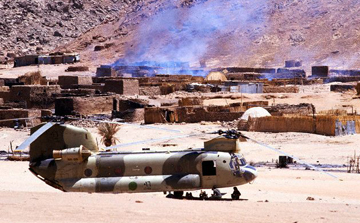 In addition to more than 7,000 Libyan soldiers, 7,000 legionnaires also arrived. Needless to say, it was impossible to enlist enough volunteers to achieve the required numbers. Libyan authorities therefore initiated a huge drive to recruit immigrant workers and refugees through deception and coercion. The French newspaper Le Monde wrote about these events: “The expeditionary corps sent to Chad – some 15,000 men – was a mixed bunch, of limited operational capacity, made up of members who were all poorly motivated: professional soldiers, certainly, but also a large number of reservists with little training, and the rest foreigners. Arabs or Africans, mercenaries in spite of themselves, wretches who came to Libya hoping for a civilian job but found themselves signed up more or less by force to go and fight in an unknown desert.”
In addition to more than 7,000 Libyan soldiers, 7,000 legionnaires also arrived. Needless to say, it was impossible to enlist enough volunteers to achieve the required numbers. Libyan authorities therefore initiated a huge drive to recruit immigrant workers and refugees through deception and coercion. The French newspaper Le Monde wrote about these events: “The expeditionary corps sent to Chad – some 15,000 men – was a mixed bunch, of limited operational capacity, made up of members who were all poorly motivated: professional soldiers, certainly, but also a large number of reservists with little training, and the rest foreigners. Arabs or Africans, mercenaries in spite of themselves, wretches who came to Libya hoping for a civilian job but found themselves signed up more or less by force to go and fight in an unknown desert.”
Further reinforcements made up the Libyan “people’s bureaus”, which were maintained in friendly countries, and which now also began to hire mercenaries with the help of Libyan petro-dollars. They recruited not only in Arab countries but also in West Africa, Bangladesh and Pakistan. Of course they weren’t particular about the truth. Many “volunteers” signed employment contracts thinking they would earn good money in the oil industry. As a result, it is estimated that in 1981 several thousand Pakistanis arrived in Libya for work and ended as legionnaires in Chad.
Despite these shortcomings, Habré’s troops were no match for the Libyan planes and tanks. They had to retreat to Sudan in defeat, but continued their fight from there. Gaddafi could now celebrate his first major victory and announced shortly afterwards the unification of Chad and Libya. However the arrogance of the occupiers rapidly spoiled relations with the native population. The Libyans favored the Arab minority in all issues and tried to radically ‘Arabise’ the country. In particular, resentment arose from the fact that indigenous women were married off to Libyan soldiers for the unification of the “inseparable peoples” in the north. Naturally the Toubou men never received Libyan women. This practice was considered with good reason as racist, and one GUNT fighter complained: “They despise us, it’s intolerable … They have married our women but they have never given us any of theirs.”
Soon heavy fighting broke out between the GUNT troops led by Goukouni and the Islamic Legion, which formed the bulk of the occupation force. The Legion suffered heavy losses both in combat as well as from desertions. More serious still was the political pressure from the African states which wanted an end to the war. When Goukouni demanded Libyan withdrawal, they withdraw their forces to the Aouzou strip at the end of 1981.
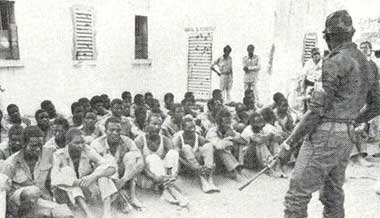 These internal struggles and the general discontent were used by Habré to invade eastern Chad. Strengthened by new alliances, he conquered the capital N’Djamena, all of the south and finally even the strategically important oasis Faya-Largeau in the north, so that the GUNT was pushed back completely into the Tibesti Mountains. This provoked a new offensive of Libyans and GUNT in June 1983. The Legion was only partially involved, probably because they still hadn’t replaced the heavy losses of 1981. The fighting focused on Faya-Largeau, which changed hands several times. Habré reorganized the various militias as FANT (Chadian National Armed Forces) and they fought quite well. Nevertheless a major Libyan offensive could only be averted by massive French intervention. The presence of French combat aircraft proved decisive, ending the Libya’s former dominance of the sky.
These internal struggles and the general discontent were used by Habré to invade eastern Chad. Strengthened by new alliances, he conquered the capital N’Djamena, all of the south and finally even the strategically important oasis Faya-Largeau in the north, so that the GUNT was pushed back completely into the Tibesti Mountains. This provoked a new offensive of Libyans and GUNT in June 1983. The Legion was only partially involved, probably because they still hadn’t replaced the heavy losses of 1981. The fighting focused on Faya-Largeau, which changed hands several times. Habré reorganized the various militias as FANT (Chadian National Armed Forces) and they fought quite well. Nevertheless a major Libyan offensive could only be averted by massive French intervention. The presence of French combat aircraft proved decisive, ending the Libya’s former dominance of the sky.
Because the French wanted to avoid by any means being drawn in a protracted war, they finally agreed with Gaddafi on a mutual troop withdrawal. The French went, but the Libyans converted Ouadi Doum in the Aouzou strip into a huge military base. France and the USA then provided the FANT with anti-air missiles and fast, converted Toyota trucks, equipped with MILAN anti-tank missiles, which granted the FANT exceptional mobility. More and more former GUNT fighters switched sides to the FANT, as the struggle against Libya increasingly came to be seen as a national affair.
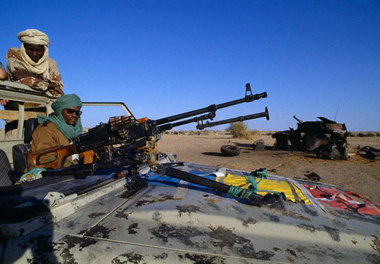 The war dragged on with each side temporarily gaining advantage over the other, but little change resulted. Finally in February 1986, Qaddafi felt strong enough to launch a major offensive with about 10,000 troops – GUNT, Libyans and Legionnaires – hundreds of tanks and numerous aircraft. After initial setbacks he sent only additional troops and matériel. But the situation had changed radically. With the help of the fast Toyotas the FANT could fall back on their traditional tactics of desert warfare. The heavily armored columns of the Libyans were unexpectedly attacked on the flanks, while smaller units were isolated and wiped out. The Libyans reacted with the methods that their Soviet instructors had taught them: heavvy artillery fire and massive tank attacks. But the Toyotas eluded the fire quickly and were hard to hit, while their Milan missiles made devastating impact.
The war dragged on with each side temporarily gaining advantage over the other, but little change resulted. Finally in February 1986, Qaddafi felt strong enough to launch a major offensive with about 10,000 troops – GUNT, Libyans and Legionnaires – hundreds of tanks and numerous aircraft. After initial setbacks he sent only additional troops and matériel. But the situation had changed radically. With the help of the fast Toyotas the FANT could fall back on their traditional tactics of desert warfare. The heavily armored columns of the Libyans were unexpectedly attacked on the flanks, while smaller units were isolated and wiped out. The Libyans reacted with the methods that their Soviet instructors had taught them: heavvy artillery fire and massive tank attacks. But the Toyotas eluded the fire quickly and were hard to hit, while their Milan missiles made devastating impact.
The costly war was far from popular in Libya, so the Islamic Legion was left to provide the most of the cannon fodder which was sacrificed in Chad. To replace the losses major efforts were made once again to recruit legionnaires. At an international conference of socialist countries in Tripoli, Gaddafi agitated for his cause, and in the people’s bureaus his agents promised the poor of the Third World fame and fortune. Allegedly 500 legionnaires came for the “holy war” from Djibouti and 2,000 from Sudan. In the mainly Christian West African countries like Ghana and Benin, on the other hand, the recruiters resorted to the banner of socialism. From Cotonou in Benin Aeroflot regularly flew youthful recruits to Libya.
When Pakistan and Bangladesh were unable to provide the required manpower fast enough, the recruiters turned to India, and it seemed that religion didn’t matter so much after all. The press reported in April 1986 about long queues in front of the Libyan people’s bureau in New Delhi. Thousands of unemployed, impoverished peasants and slum dwellers had been attracted by ads that promised a month’s pay from 833 up to 1,666 dollars. Particularly sought were ex-soldiers, technicians and pilots, but others were also welcome. One of those waiting in line said: “Here I am starving. If I die in Libya, at least my children will have enough to survive”. Libya called the whole campaign an act of solidarity by Indians against U.S. imperialism. Finally, however, India ended the business because of pressure from the U.S. government.
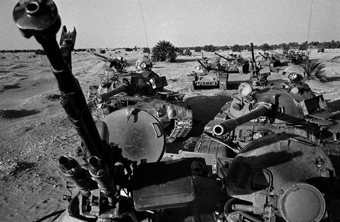 But the legionnaires, who were hurriedly sent to the front, couldn’t change the muddled situation in Chad. Meanwhile whole units from the GUNT went over to the enemy, so that finally open fighting broke out between them and the Libyans. Gaddafi ordered that the camps and settlements of his former comrades in arms be bombed with napalm and probably also with poison gas. Nevertheless, the situation for the Libyan troops deteriorated rapidly. Without local allies their columns moved nearly blind through the country. They entrenched behind minefields, barbed wire, earthworks and dug in tanks. Their bases, with their depots, artillery and airfields, grew into impressive fortresses.
But the legionnaires, who were hurriedly sent to the front, couldn’t change the muddled situation in Chad. Meanwhile whole units from the GUNT went over to the enemy, so that finally open fighting broke out between them and the Libyans. Gaddafi ordered that the camps and settlements of his former comrades in arms be bombed with napalm and probably also with poison gas. Nevertheless, the situation for the Libyan troops deteriorated rapidly. Without local allies their columns moved nearly blind through the country. They entrenched behind minefields, barbed wire, earthworks and dug in tanks. Their bases, with their depots, artillery and airfields, grew into impressive fortresses.
The biggest of these complexes was Ouadi Doum, where up to 7,000 men with numerous tanks were entrenched behind extensive minefields. Nevertheless the FANT succeeded in early 1987 to engage a strong column which it wiped out in a ferocious battle. A relief column from Ouadi Doum suffered the same fate. It is likely that they followed the fleeing soldiers and launched a surprise attack at night. Although heavily outnumbered, they couldn’t be stopped – many years later burned out Toyota wrecks still remained as evidence of the heavy fighting. When the attackers broke the first line of defense, the Libyans were routed. Many were reportedly killed during their flight by their own mines, and for others it was a desperate undertaking to reach their own positions through the unknown wilderness.
After the loss of Ouadi Doum the war was lost for Libya. Faya-Largeau was evacuated without a fight, and the remaining bases in the Aouzou strip were abandoned shortly after or conquered by the FANT. The battered and demoralised remnants of the Islamic Legion were mostly dissolved. Only a few units were sent to Sudan, and from Darfur they made incursions into eastern Chad. As a result the government of Chad reported 44 legionaries killed in fighting along the eastern border in November 1987. The legionnaires who had fallen into captivity, were mostly sent back to their countries of origin, which was always a nice victory for propaganda. Some were even recruited in the prison camps by the CIA, together with several hundred Libyans for future coup attempts against Gaddafi.
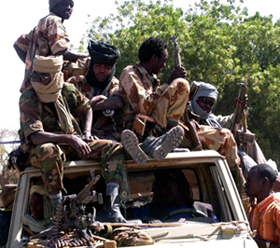 Nevertheless, the history of the Islamic Legion was not quite at its end. Some legionnaires could not return to their home countries and others had taken a fancy to the military life. Among the latter the Arab Bedouin from the Sahel were dominant including many emigrants from Sudan and Chad. Discreetly supported by Gaddafi, they retreated into the trackless desert of northwestern Sudan and led an existence there as arms dealers, smugglers and highwaymen. The government of Sudan turned a blind eye to these activities, since it was more than busy with the rebels in the south, and furthermore nobody knew what this group of desperate men could be used for in the future.
Nevertheless, the history of the Islamic Legion was not quite at its end. Some legionnaires could not return to their home countries and others had taken a fancy to the military life. Among the latter the Arab Bedouin from the Sahel were dominant including many emigrants from Sudan and Chad. Discreetly supported by Gaddafi, they retreated into the trackless desert of northwestern Sudan and led an existence there as arms dealers, smugglers and highwaymen. The government of Sudan turned a blind eye to these activities, since it was more than busy with the rebels in the south, and furthermore nobody knew what this group of desperate men could be used for in the future.
Their moment came in 2003 when a rebel group in Darfur attacked a Sudanese military base. Most of the government troops were occupied in the south, so the infamous Janjaweed came into being, which gave rise to headlines around the world in the years following of genocide and the ethnic cleansing of the local black population. Even though many of the Janjaweed were Bedouins from northern Sudan, the hardcore membership was made up of the veterans of Gaddafi’s Islamic Legion. The pan-Arab racist ideology which they had been fed over the years bore its fruits in Darfur.



